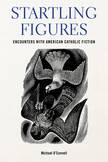Review: A lively journey through Catholic fiction
Years ago, I taught a college seminar on “The Literature of First Novels.” A last-minute substitute, I went with the syllabus provided: Toni Morrison’s The Bluest Eye, John Updike’s Poorhouse Fair, Flannery O’Connor’s Wise Blood and more. All interesting, but my students were befuddled. What connected these texts other than that they were the authors’ firsts?
The class and I chewed on that question for many weeks. What we finally arrived at felt insufficient but ultimately satisfied: Those first books were each an author’s way of laying down a marker, announcing themselves, declaring: I’m here.
I thought of that seminar as I paged through Michael O’Connell’s Startling Figures: Encounters With American Catholic Fiction, which gathers analyses of Flannery O’Connor, J. F. Powers, Walker Percy, Tim Gautreaux, George Saunders and Alice McDermott, along with capsule takes in the introduction and epilogue of Tobias Wolff, Ron Hansen, Andre Dubus, Phil Klay and Kirstin Valdez Quade. It’s hard—though fun—to imagine them sitting around the same table, let alone sharing the pages of a single slim volume.
“I have found,” Flannery O'Connor writes in Mystery and Manners, “that violence is strangely capable of returning my characters to reality and preparing them to accept their moment of grace.”
O’Connell recognizes that. In an endnote, he mentions that “one of the challenges in writing this book was deciding which authors to include.” He holds that:
O’Connor, Percy, and Powers best represent the American Catholic tradition in their given time period, but outside of these three, it would be possible to choose an entirely different set of American writers...including, say, Cormac McCarthy, Annie Dillard, and Toni Morrison.
Morrison’s absence seems the biggest in O’Connell’s book, but then, she deserves a spiritually lensed book of her own (and has one, thanks to the 2022 book by America contributor Nadra Nittle, Toni Morrison’s Spiritual Vision: Faith, Folktales, and Feminism in Her Life and Literature).
More curious to me than who made the cut, though, was the lodestar O’Connell chose for his study: violence, which he says Catholic writers often “employ...to shape their readers’ experience of the text.” It is “remarkable,” he continues, “how often characters in Catholic literature suffer, in upsetting, shocking, disorienting ways.” He cites O’Connor on the subject: “I have found,” she writes in Mystery and Manners, “that violence is strangely capable of returning my characters to reality and preparing them to accept their moment of grace.”
Not surprisingly, O’Connor is the first author O’Connell examines at length in this book, subjecting both the classic short story “A Good Man Is Hard to Find” and the still-strange 1952 novel Wise Blood to smart, thorough readings.
“A Good Man Is Hard to Find,” the story of a family car trip interrupted by a prison escapee known as the Misfit, is particularly useful to O’Connell. How could it not be? After shooting the grandmother, the Misfit famously intones that she “would’ve been a good woman, if it had been somebody there to shoot her every minute of her life.” O’Connell suggests that the Misfit (who is white), is:
representative of a segment of society that was more or less created by the exclusionary practices of the White elite and has now turned violent. In this story, we see that the patriarchal system, built on the violence and oppression of slavery, leads to the production of violent figures like the Misfit, who in turn contribute to the further disruption of order in the modern world.
In this chapter, O’Connell also begins to move his argument past whether violence is a defining characteristic of American Catholic fiction—it is, it is, it is, this book seems to say—to the more interesting, if elusive, question of why. In O’Connor’s case, “violence...is her attempt to shock her audience into seeing reality anew.” The word askew might better finish that sentence, but no matter; O’Connell’s larger point is that she “does not simply want to capture her reader’s attention, [but] wants to lead them toward the same kind of radical conversion her characters undergo.”
Though very much in keeping with O’Connor’s other writings, this is a bold point, and a good point for amenable readers to stop and search their own souls: Has O’Connor ever led them to conversion? Has any literature? Engagingly, O’Connell charts his own (what I would call a) conversion experience, digressing to talk about encountering this short story for the first time in college, being “baffled” by it, and retreating to the upper reaches of the Hesburgh Library at Notre Dame, where he spent hours “puzzling over her stories, her letters, her essays, trying to put it all together.” That he chose further study over chucking the book across the room seems evidence of a powerful conversion indeed.
Startling Figures itself may convert lay readers to academic books. It’s readable, relatable and lively. Little theory is summoned; focused, accessible close readings do most of the work. I found myself eagerly making margin notes and underlining passages early in the book, though less so later. It’s not that the analyses of post-O’Connor authors were less keen, but that the argument about violence’s centrality seemed to have been largely settled by the time I reached those pages.
That doesn’t mean I wasn’t still surprised to see violence crop up in a discussion of the mild and mirthful J. F. Powers—though O’Connell did remind me that the title character of Powers’s National Book Award-winning novel, Morte d’Urban, is felled by a painful golf ball to the skull. And Alice McDermott: Surely there’s no violence there? But yes, The Ninth Hour, her “most explicitly Catholic book,” opens in the aftermath of a suicide.
Startling Figures itself may convert lay readers to academic books. It’s readable, relatable and lively.
That said, I wondered if violence played as catalytic a role in McDermott and some of the later texts discussed. In McDermott and Saunders, violence is present but seems less of an axis; in McDermott’s work in particular—and here’s to a dozen more books shining a light on this greatest of contemporary authors, Catholic and not—I feel more struck by the exemplars of “the goodness and loving kindness of God,” as Titus 3:4 would have it. McDermott’s characters are often broken, but also resilient, especially in the face of violence.
So, too, in the work of George Saunders. Saunders initially seems the odd man out, but O’Connell makes a compelling case, backed up by material found in another book, Conversations With George Saunders, which O’Connell edited. He quotes from it frequently and trenchantly: “Once a person has a glimpse of mystery,” O’Connell reports Saunders saying, “he’s always going to be seeking that.”
Ultimately, what stirred me most was O’Connell’s declaration in his closing pages that he does “not find questions about the viability or ongoing existence of the Catholic novel to be particularly compelling (the Catholic novel, like the novel in general, will continue to exist in one form or another even as critics and readers continue to forecast its death),” but rather that he is “interested in the way the Catholic novel continues to evolve and change to reflect the contemporary moment.”
To be clear, I forecast life, not death. And to echo that first novels class I taught, I detect a similar assertion among the Catholic writers gathered here: We’re here. And: to stay. That may not be startling, but the assessment of that claim by this generous, capacious book ceaselessly is.
This article also appeared in print, under the headline “Disorienting Catholic Fiction,” in the March 2024, issue.











